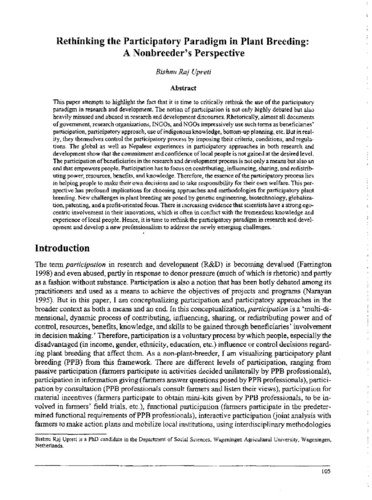Cassava research program at Tamil Nadu Agricultural University (TNAU) in India
Abstract
Cassava is cultivated in Tamil Nadu in an area of 85,983 ha with an annual production of about 2.5 million t of roots (1993-94). At the world level, Tamil Nadu ranks first in yield, with 28.7 t/ha, as compared to the Indian average of 22.8 and a world average of 9.6 t/ha. In Tamil Nadu cassava is grown mainly in Salem and Kanyakumari districts located in the dry western zone (60% irrigated and 40% rainfall) and the high rainfall southern zone (mostly rainfed), respectively. The area under cassava is increasing in other districts of Tamil Nadu as well.
With respect to varieties, about 50% of the total area is grown with high-yielding varieties, like H-226 and MVD-1 in most areas of Salem district, and with Co-1, Co-2, Co-3 in different parts of Tamil Nadu. Locally adapted and traditional varieties, like Burma and Malabar, are still under cultivation, but they are low yielding and susceptible to cassava mosaic disease.
The cassava germplasm collection has now increased to 480 accessions, including some CIAT clones. Two early maturing clones were identified, i.e., H-1 19 from CTCRI, Trivandrum, and Co-3 developed by Tamil Nadu Agr. Univ. in Coimbatore. The crop duration is 7 1/2 to 8 months with a high yield of 32 and 35 t/ha, respectively, and a starch content of about 30 % . For the high rainfall zone of Kanyakumari district, the local clone Adukkumuttan performs well, giving a 15 to 28% increase in yield compared to the released varieties. For coastal areas of South Arcot district, two clones, i.e. ME-46 and ME-10, were shown to be better, with a yield of 44 t/ha; these are now under further evaluation. Under the Asian cassava breeding network a total number of 85 hybrid progenies were received from CIAT/Colombia and the Thai-CIAT program. Preliminary evaluation has indicated that a few clones have high root yields of more than 5 kg/plant, high starch content of over 35%, field tolerance to mosaic virus and a shorter crop duration of 7 to 8 months.
The optimum fertilizer rate for Co-3 cassava under irrigated conditions was found to be 60:60:120 kg N-P2O5-KO/ha, which increased the yields by 36% over the control. For the recently developed short-duration clones, like H-1 19, CI-590and S-856, under irrigated conditions the optimum spacing and fertilizer requirements are 75 x 75 cm and 75:25:75kg N-P2O5-K2O/ha, respectively. Application of Azospirillum inoculum at 2 kg/ha as basal dressing with recommended fertilizers, combined with three foliar sprays of zinc sulfate (0.5%) and iron sulfate (1.0%) at 60, 75 and 90 days after planting, increased the root yield and starch content of Co-1 and Co-2 varieties. Under abundant water supply, cassava intercropped with groundnut can be irrigated at 0.6 IW/CPE ratio with an interval of 12 days and the application at 10 t/ha of coconut husk waste. Under limited water supply, irrigation may be reduced to 0.45 IW/CPE ratio with an interval of 16 days.

